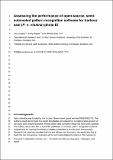Assessing the performance of open-source, semi-automated pattern recognition software for harbour seal (P. v. vitulina) photo ID
Abstract
Photographic identification (photo ID) is a well-established, non-invasive, and relatively cost-effective technique to collect longitudinal data from species that can be individually recognised based on natural markings. This method has been improved by computer-assisted pattern recognition software which speed up the processing of large numbers of images. Freely available algorithms exist for a wide range of species, but the choice of software can have significant effects on the accuracy of individual capture histories and derived demographic parameter estimates. We tested the performance of three open source, semi-automated pattern recognition software algorithms for harbour seal (Phoca vitulina vitulina) photo ID: ExtractCompare, I3S Pattern and Wild-ID. Performance was measured as the ability of the software to successfully score matching images higher than non-matching images using the cumulative density function (CDF). The CDF for the top ranked potential match was highest for Wild-ID (CDF1 = 0.34–0.58), followed by ExtractCompare (CDF1 = 0.24–0.36) and I3S pattern (CDF1 = 0.02–0.3). This trend emerged regardless of how many potential matches were inspected. The highest performing aspects in ExtractCompare were left heads, whereas in I3S Pattern and Wild-ID these were front heads. Within each aspect, images collected using a camera and lens performed higher than images taken by a camera and scope. Data processing within ExtractCompare took > 4 × longer than Wild-ID, and > 3 × longer than I3S Pattern. We found that overall, Wild-ID outperformed both ExtractCompare and I3S Pattern under tested scenarios, and we therefore recommend its assistance in harbour seal photo ID.
Citation
Langley , I , Hague , E & Arso Civil , M 2022 , ' Assessing the performance of open-source, semi-automated pattern recognition software for harbour seal ( P. v. vitulina ) photo ID ' , Mammalian Biology , vol. 102 , pp. 973-982 . https://doi.org/10.1007/s42991-021-00165-8
Publication
Mammalian Biology
Status
Peer reviewed
ISSN
1616-5047Type
Journal article
Description
Funding: Data collection was funded by the Scottish Government (grant number MMSS/002/15)Collections
Items in the St Andrews Research Repository are protected by copyright, with all rights reserved, unless otherwise indicated.

